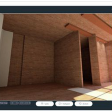Human-sized musical interfaces 🎛
This year I’ve been thinking about scale. Miniaturisation is unstoppable, but maybe there’s a way we can have our cake and eat it.
Eurorack modular synths are getting smaller and denser.
An amazing community of DIY builders are taking tiny compact modules with open-source licenses — including Ornament & Crime and Mutable Instruments and making them even smaller.
This is undoubtedly a good thing — powering a trend for tiny, relatively affordable, battery powered modular synths with remarkable amounts of power in a small space.
My last new design, Startup, was a response to this trend — the smallest possible useful stereo mixer/headphone amp/clock for tiny cases.
This year I’ve spent a lot of time playing with really really tiny interfaces, but recently I’ve been wondering if there is another way.
Not all interfaces are getting smaller and denser.
My friend Tom Armitage is part of the team behind 16n, a beautiful, minimalist bank of 16 faders that sits alongside a modular synth, a Monome Norns or a laptop. Marcus Fischer used one at the Whitney Biennal and here are Tom Hall and Robin Rimbaud using the 16n.
Separating the controls from the device does something interesting. It makes you listen. An unmarked, arbitrary control has to influence the sound somehow to make any sense. Otherwise it’s just moving a bit of plastic.
This is slightly different from a traditional control. When the DJ tweaks the EQ as a record plays, it’s sometimes about performance — having something to do — rather than about sound. They know what the knob does, so tweaking it is a rational action, whether it has any actual audible impact on the sound or not. Tweaking an unmarked control has to have impact to be meaningful. Sometimes, of course, it’s all about the performance (thanks Chris).
Monome’s Arc is another beautiful thing: weighted encoders with LED rings, which seems makes control a bit more calm peaceful (it also does a lot more along the way).
Rotary DJ mixers are another fully-fledged cult (here’s Peggy Gou on the Isonoe 420) which is at least partly about slow, deliberate movements, compared with quick-fire crossfader of the scratch DJ.
This year, Meng Qi’s Wing Pinger has built on Rob Hordijk’s Blippoo Box, both standalone devices which seem to respond best to small movements and lots of listening, meditative (and noisy).
Finally, there’s the Cult of Test Equipment, pioneered I think by Dennis Vershoor at WORM in Rotterdam and popularised by videos from Hainbach and Look Mum No Computer. To my eyes, a big part of this is really the Cult of Really Big Knobs.
The bible for the Cult of Really Big Knobs could be Standard 1472 (big PDF), the document that sets out human interface guidelines for the US military, everything from ergonomics to display guidelines to, on page 68, the size, design and spacing of all kind of knobs. (Spoiler: Serge synths — 10mm pots with 1 inch spacing — comply with the minimum requirements).
How does all this apply to making music?
The theory is about Musical Gesture. “A pianist’s hands literally shape a phrase through gesture; a conductor can communicate with his players because his subtlest physical gestures are translated into musical ones. The maker of music must literally feel the gestures he offers up in sound.” (Edward Rothstein in the NYT in 1982, when all musicians were apparently men).
I can’t claim to understand (or have read) ‘Diagrams, gestures and formulae in music’ by Mazzola &Andreatta, but I did like this image:
A big knob controller for Eurorack
So that’s how I ended up with Control. It’s an absurdly simple module: Four big knobs that output voltages. Connect those voltages to modules, and you have high-precision, intuitive control. Connect those voltages to several modules, and you have interesting, repeatable confusion.
- The first two channels (top two knobs) are also attenuators if something is plugged into the leftmost sockets.
- The voltage on each channel can be 0–5v (middle), 0–10v (up), or -5v to +5v (down). When using a channel as an attenuator, keep it in 0–5v or you’ll get weird gain or offset (which you may want).
- There are two extra outputs.Change outputs just the changes as they happen. If a knob is turned quickly to the right, it will output a little burst of positive voltage. If a four-handed performer turns all four knobs quickly anti-clockwise, it will output a chunky pulse of negative voltage. Patching Change into an input creates a primitive clock.
- Diff is a difference rectifier, inspired by NonlinearCircuits, but with a slightly different circuit. It compares the difference between 1&2, and between 3&4, and finally outputs the difference between those two differences. The aim was to create a bumpy, unpredictable voltage between 0 and 10v. It’s not random, but it’s not easily predictable, either.
And that’s it.
Until May 15th you can bid for a prototype Control kit and raise money for Lambeth Food Bank: Details on how to bid are here
The circuit is a stack of slow, stable, old (cheap) LM324 op amps, and the pots are TT Electronics P260T, nice high quality pots used in SynthTech modules and many 5U synths. They have steel shafts bolted to the front panel and they feel great.
My first prototype had sockets at the bottom, but I quickly realised it makes more sense the other way around, with sockets at the top.
The knobs themselves are a matter of personal choice.
Kits from Thonk will come with Davies 1600BM knobs — the kind used for fine control on the earliest Buchla systems, but the mighty Davies 4104CB also works very well.
Tom Whitwell designs circuits as Music Thing Modular, and all his designs are available to buy at Thonk. You might also enjoy: How I recorded an album in an evening with a lunchbox modular and a python script or Chord Organ: The easiest way to get simple chords from a modular synth. Also, I went to see La Monte Young playing in his New York loft, and you should do the same.



